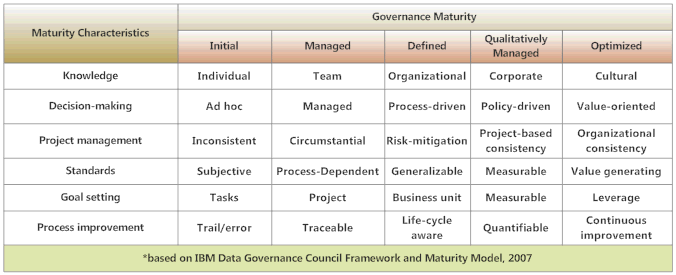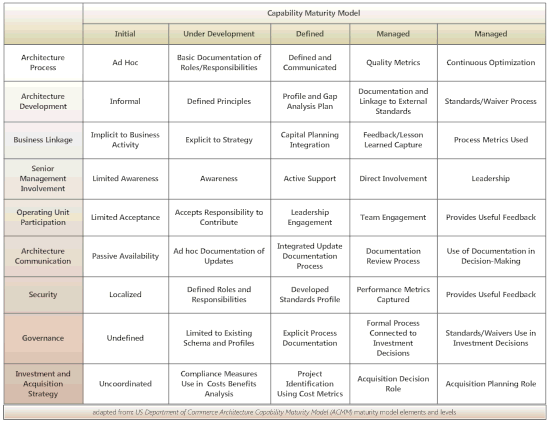Players
To be a core part of the business management structure, executive level accountability, access, backing, and participation are essential to success. To be institutional approach governance is implemented by recognized team of players in which to roles, accountabilities, communications, and information flows are defined. Governance-related decisions are organizational policies for implementation by operational managers and individuals at the tactical level. Organizationally, therefore, governance is constituted as a forum under executive sponsorship with membership representing each stakeholder group. While the nature of membership participation varies relative to the activity and projects, the salient feature is that there is a regular form for mediating change requirements as they arise across the enterprise. Lack of a forum for educating executives is as deadly to projects aimed at keeping the enterprise resilient as perspective on business sustainability drivers. Often associated with the activity of IT, that association is challenged by internal and external user information architecture, search, access, and data retrieval requirements. Advent of cloud and scripted processes unconstrained by tables and managed across massive server arrays add further complexity. Simplification of complexity of governance is achieved to the extent that it is a vehicle for creating knowledge assets and delivering solutions to content, data, and information access needs of end-users, either external or internal.
Maturity
A strategic tool, governance directs its attention to the achievement of optimal maturity across the information-knowledge management domains. Maturity can be defined as reaching a level of growth to produce results that makes the organization capable of creatively responding to continuous change as part of the ordinary course of business.
Industry and technology maturity models are heuristics for framing that is defining the boundaries, of governance practices. The IBM Data Governance Council Framework and Maturity Model, when modestly generalized, is an outstanding explication of maturity characteristics.

Enhancement of the IBM-performative characteristics approach to maturity with the capability-centric maturity model of the U.S. Department of Commerce, IT Architectural Capability Maturity Model provides a significantly richer view of the governance as an organizational maturity strategy.

Standards
Standards are instruments enabling evaluation of compared objects. As such, standards are essential for interoperability, for reuse/repurposing of assets, and for achieving consistent self-expression.
Information governance produces localized standards representing the knowledge system of an enterprise. In so doing, enterprises have the ability to store, search, access, and flexibly use their information assets, whether these assets are data, textual, graphical, or audio.
An Enterprise-centric Approach
Governance products include essential enterprise-level knowledge management standards without which organizations lose control of their intellectual capital resources.
- Taxonomies are enterprise dictionaries that support enterprise writing style guides. Writing style guides are critical for ensuring language that language is not only consistent and meaningful, while ensuring that information can be consistently identified and found salient to user needs by automated search tools.
- Enforcing metadata fields and requiring definitions established enterprise-specific semantic standards that ensure quantitative data is used and interpreted accurately.
- Content component definitions and models are enterprise-specific standards for creating knowledge products based on available assets.
The ability to efficiently use internal information standards to deliver highly salient, very precise information to users the governance process must be informed by the use tools consistent with, and seek methods to leverage, external standards.
Systems Interoperability and External Standards
Many external standards exist, creating a set of framework tools for passing units of information between technologies and systems that would otherwise be incompatible. These external standards are often created and managed through international organizations. Essential knowledge access and processing standards include those supported by the World Wide Web Consortium (W3C), the Dublin Core Initiative (DC), the Organization for the Advancement of Structured Information Standards (OASIS), the International Standards Organization (ISO), and the American National Standards Institute (ANSI).
Governance includes consideration vendor-specific standards issues. Some vendors, Adobe for example, with its XMP metadata system for digital assets, attempting to establish themselves as de facto standard owners. Platform manufacturers also attempt to promote or demote various technologies, for example Apple's refusal to support Adobe Flash prior to the release of HTML5.
Resourcefulness
Building an enterprise governance process is an integral part of developing human capital, organizational culture, resilience to change, and enterprise sustainability.
Process
As an enterprise process, governance approaches incorporate the unique needs of each organization and based on tasks, membership, the nature of the supported systems, and the organizations existing culture. Nevertheless, basic workflow patterns include having a governance coordinator.
Taxonomist/governance coordinator receives, evaluate, prioritize, report on, and, depending on the system, implement change requests. Governance coordinators lead the governance team, working with others to reach a decisions, communicating and informing stakeholders.
The core processes also provide on-going training and guidance to internal users on taxonomy, metadata, and systems, ensuring requests are complete and consistent with existing architectures, have well-defined scope and semantics, and capable of supporting intended goals.
Governance as a Resilience and Sustainability Resource
With a governance mission of knowledge system maturity and an organization approach that makes it an internal knowledge development forum, good governance practices provide enterprises with an essential repository of technical knowledge the absence of which reduces an enterprise's ability resilience to uncontrollable external changes taking places with customers, markets and technology, and limiting internal sustainability requirements of managers and innovators.
Given its unique role and the skill sets associated with governance, a range of tasks, such as platform migration, content analysis and metadata enhancement, information flow and needs assessment.